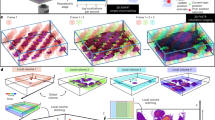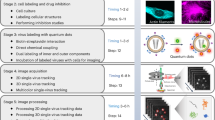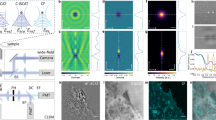Abstract
Optical studies have revealed that, after binding, virions move laterally on the plasma membrane, but the complexity of the cellular environment and the drawbacks of fluorescence microscopy have prevented access to the molecular dynamics of early virus-host couplings, which are important for cell infection. Here we present a colocalization methodology that combines scattering interferometry and single-molecule fluorescence microscopy to visualize both position and orientation of single quantum dot–labeled Simian virus 40 (SV40) particles. By achieving nanometer spatial and 8 ms temporal resolution, we observed sliding and tumbling motions during rapid lateral diffusion on supported lipid bilayers, and repeated back and forth rocking between nanoscopic regions separated by 9 nm. Our findings suggest recurrent swap of receptors and viral pentamers as well as receptor aggregation in nanodomains. We discuss the prospects of our technique for studying virus-membrane interactions and for resolving nanoscopic dynamics of individual biological nano-objects.
This is a preview of subscription content, access via your institution
Access options
Subscribe to this journal
Receive 12 print issues and online access
$259.00 per year
only $21.58 per issue
Buy this article
- Purchase on Springer Link
- Instant access to full article PDF
Prices may be subject to local taxes which are calculated during checkout





Similar content being viewed by others
References
Betzig, E. Proposed method for molecular optical imaging. Opt. Lett. 20, 237–239 (1995).
Hell, S.W. Far-field optical nanoscopy. Science 316, 1153–1158 (2007).
Hettich, C. et al. Nanometer resolution and coherent optical dipole coupling of two individual molecules. Science 298, 385–389 (2002).
Yildiz, A. et al. Myosin V walks hand-over-hand: Single fluorophore imaging with 1.5-nm localization. Science 300, 2061–2065 (2003).
Betzig, E. et al. Imaging intracellular fluorescent proteins at nanometer resolution. Science 313, 1642–1645 (2006).
Rust, M.J., Bates, M. & Zhuang, X. Sub-diffraction-limit imaging by stochastic optical reconstruction microscopy (STORM). Nat. Methods 3, 793–795 (2006).
Hess, S.T. et al. Dynamic clustered distribution of hemagglutinin resolved at 40 nm in living cell membranes discriminates between raft theories. Proc. Natl. Acad. Sci. USA 104, 17370–17375 (2007).
Moerner, W.E. & Orrit, M. Illuminating single molecules in condensed matter. Science 283, 1670–1676 (1999).
Weiss, S. Fluorescence spectroscopy of single biomolecules. Science 283, 1676–1683 (1999).
Thompson, R.E., Larson, D. & Webb, W. Precise nanometer localization analysis for individual fluorescent probes. Biophys. J. 82, 2775–2783 (2002).
Schmidt, T., Schutz, G., Baumgartner, W., Gruber, H. & Schindler, H. Imaging of single molecule diffusion. Proc. Natl. Acad. Sci. USA 93, 2926–2929 (1996).
Seisenberger, G. et al. Real-time single-molecule imaging of the infection pathway of an adeno-associated virus. Science 294, 1929–1932 (2001).
Lindfors, K., Kalkbrenner, T., Stoller, P. & Sandoghdar, V. Detection and spectroscopy of gold nanoparticle using supercontinuum white light confocal microscopy. Phys. Rev. Lett. 93, 037401 (2004).
Jacobsen, V., Stoller, P., Brunner, C., Vogel, V. & Sandoghdar, V. Interferometric optical detection and tracking of very small gold nanoparticles at a water-glass interface. Opt. Express 14, 405–414 (2006).
Ewers, H. et al. Label-free optical detection and tracking of single virions bound to their receptor in supported membrane bilayers. Nano Lett. 7, 2263–2266 (2007).
Liddington, R.C. et al. Structure of Simian Virus-40 at 3.8-A resolution. Nature 354, 278–284 (1991).
Tsai, B. et al. Gangliosides are receptors for murine polyoma virus and SV40. EMBO J. 22, 4346–4355 (2003).
Neu, U., Woellner, K., Gauglitz, G. & Stehle, T. Structural basis of GM1 ganglioside recognition by Simian Virus 40. Proc. Natl. Acad. Sci. USA 105, 5219–5224 (2008).
Churchman, L.S., Okten, Z., Rock, R.S., Dawson, J.F. & Spudich, J.A. Single molecule high-resolution colocalization of Cy3 and Cy5 attached to macromolecules measures intramolecular distances through time. Proc. Natl. Acad. Sci. USA 102, 1419–1423 (2005).
Kukura, P., Celebrano, M., Renn, A. & Sandoghdar, V. Imaging a single quantum dot when it is dark. Nano Lett. 9, 926–929 (2009).
Einstein, A. A new determination of the molecular dimensions. Ann. Phys. 19, 289–306 (1906).
Ewers, H. et al. Single-particle tracking of murine polyoma virus-like particles on live cells and artificial membranes. Proc. Natl. Acad. Sci. USA 102, 15110–15115 (2005).
Shi, J. et al. GM1 clustering inhibits cholera toxin binding in supported phospholipid membranes. J. Am. Chem. Soc. 129, 5954–5961 (2007).
Frey, S. et al. Condensing and fluidizing effects of ganglioside GM1 on phospholipid films. Biophys. J. 94, 3047–3064 (2008).
Fujita, A. et al. Gangliosides GM1 and GM3 in the living cell membrane form clusters susceptible to cholesterol depletion and chilling. Mol. Biol. Cell 18, 2112–2122 (2007).
Eggeling, C. et al. Direct observation of the nanoscale dynamics of membrane lipids in a living cell. Nature 457, 1159–1162 (2009).
Jacobsen, V., Klotzsch, E. & Sandoghdar, V. Interferometric detection and tracking of nanoparticles. in Nano Biophotonics (eds., Masuhara, H., Kawata, S. & Tokunaga, F.) 143–160 (Elsevier, Amsterdam, 2007).
Damm, E.M. et al. Clathrin- and caveolin-1independent endocytosis: entry of Simian Virus 40 into cells devoid of caveolae. J. Cell Biol. 168, 477–488 (2005).
Kusumi, A. et al. Paradigm shift of the plasma membrane concept from the two-dimensional continuum fluid to the partitioned fluid: High-speed single-molecule tracking of membrane molecules. Annu. Rev. Biophys. Biomol. Struct. 34, 351–378 (2005).
Kalb, E., Frey, S. & Tamm, L.K. Formation of supported planar bilayers by fusion of vesicles to supported phospholipid monolayers. Biochim. Biophys. Acta 1103, 307–316 (1992).
Kosukegawa, A. et al. Purification and characterization of virus-like particles and pentamers by the expression of SV40 capsid proteins in insect cells. Biochim. Biophys. Acta 1290, 37–45 (1996).
Acknowledgements
We thank the Swiss Ministry of Education and Research for financial support (EU Integrated project Molecular Imaging), J. Helenius for comments, R. Mancini for providing electron micrographs of quantum dots, A. Oppenheim (Department of Hematology, Hebrew University, Hadassah Medical School and Hadassah Hospital, Jerusalem) for providing SV40 VLPs and Gunter Schwarzmann (Kekule-Institut für Organische Chemie, Universität Bonn) for NBD-GM1. A.H. thanks the Swiss National Science Foundation (SNF) for financial support.
Author information
Authors and Affiliations
Contributions
P.K. designed the experimental setup, performed SV40 experiments and analyzed data. H.E. performed FRAP experiments and purified and labeled SV40. H.E. and C.M. prepared supported lipid bilayers. V.S. conceived and supervised the project in collaboration with A.H.; V.S., P.K. and H.E. wrote the manuscript; and P.K., H.E., C.M., A.R., A.H. and V.S. discussed the results and commented on the manuscript.
Corresponding author
Supplementary information
Supplementary Text and Figures
Supplementary Figures 1–2 (PDF 257 kb)
Supplementary Video 1
Sequence of 500 consecutive iSCAT (left) and fluorescence (right) images acquired at a frame rate of 130 Hz. The frame rate has been reduced to 25 frames s−1 for clarity. (MOV 3496 kb)
Supplementary Video 2
Illustrative 3D rendering of a 200 frame selection from simultaneously acquired iSCAT and fluorescence trajectories. (MOV 3305 kb)
Supplementary Video 3
Sequential illustration of Figure 5b from the manuscript at the experimental acquisition speed of 25 frames s−1. (MOV 74 kb)
Supplementary Video 4
Sequential illustration of Figure 5c from the manuscript at the experimental acquisition speed of 25 frames s−1. (MOV 25 kb)
Supplementary Video 5
Sequential illustration of Figure 5d from the manuscript at the experimental acquisition speed of 25 frames s−1. (MOV 135 kb)
Supplementary Video 6
Sequential illustration of Figure 5e from the manuscript at the experimental acquisition speed of 25 frames s−1. (MOV 217 kb)
Supplementary Video 7
Sequential illustration of Figure 5f from the manuscript at the experimental acquisition speed of 25 frames s−1. (MOV 154 kb)
Rights and permissions
About this article
Cite this article
Kukura, P., Ewers, H., Müller, C. et al. High-speed nanoscopic tracking of the position and orientation of a single virus. Nat Methods 6, 923–927 (2009). https://doi.org/10.1038/nmeth.1395
Received:
Accepted:
Published:
Issue Date:
DOI: https://doi.org/10.1038/nmeth.1395
This article is cited by
-
Temporal analysis of relative distances (TARDIS) is a robust, parameter-free alternative to single-particle tracking
Nature Methods (2024)
-
Viewing life without labels under optical microscopes
Communications Biology (2023)
-
Single virus fingerprinting by widefield interferometric defocus-enhanced mid-infrared photothermal microscopy
Nature Communications (2023)
-
Long-term cargo tracking reveals intricate trafficking through active cytoskeletal networks in the crowded cellular environment
Nature Communications (2023)
-
Confocal interferometric scattering microscopy reveals 3D nanoscopic structure and dynamics in live cells
Nature Communications (2023)



